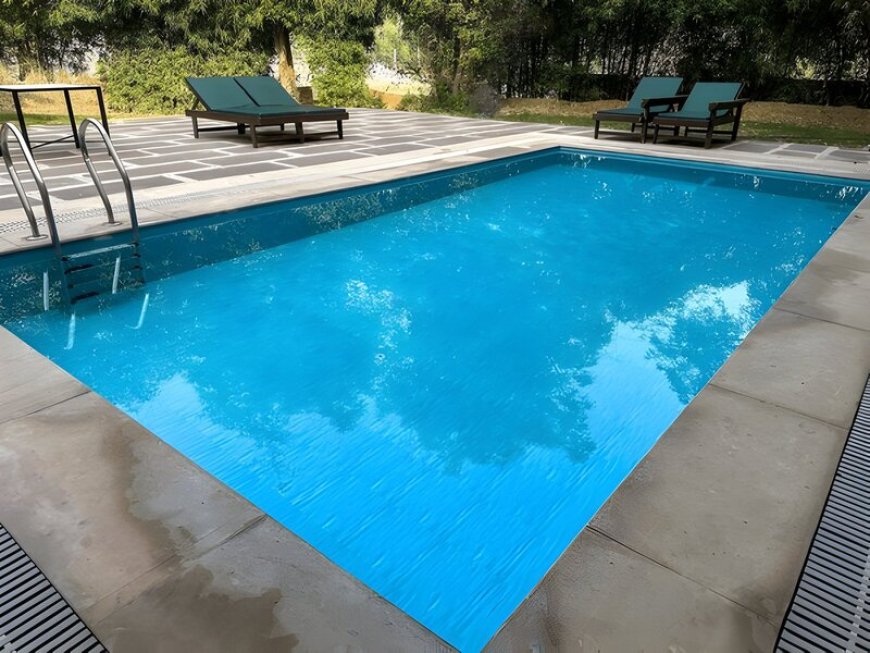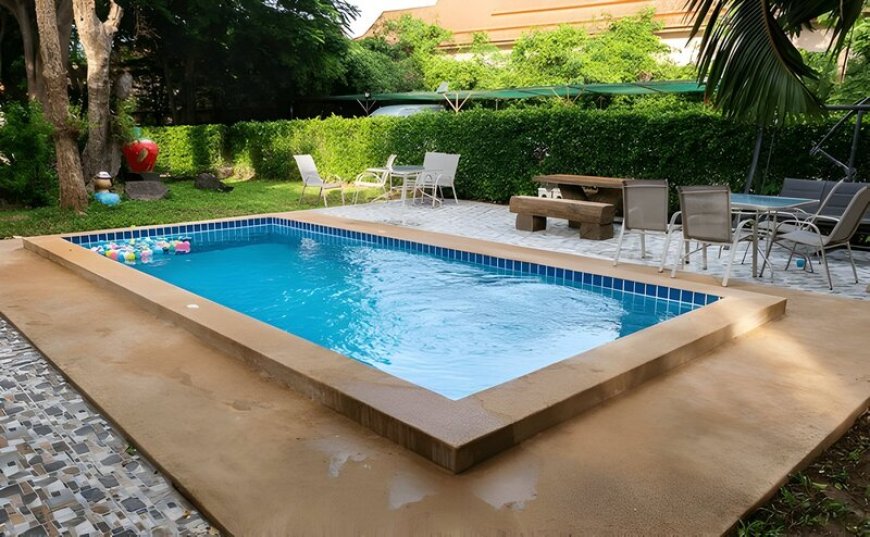How to Build and Maintain a Concrete Swimming Pool: A Complete Guide
Know how to build and maintain a concrete swimming pool with our complete guide, covering design, construction, maintenance tips, and long-term care.

A swimming pool can transform your backyard into a personal retreat, a space for relaxation, entertainment, and exercise. If you're considering adding a pool to your home, a concrete swimming pool is an excellent choice. Unmatched long-term value, design flexibility, and durability are provided by concrete pools. In this guide, we'll take you through everything you need to know about building and maintaining a concrete swimming pool, from the initial planning stages to long-term upkeep.
Why Choose a Concrete Swimming Pool?
Swimming pools made of concrete are known for their durability and adaptability. Unlike fiberglass or vinyl pools, which come in pre-determined shapes and sizes, concrete pools can be custom-built to fit your specific design preferences. Whether you're envisioning a classic rectangular pool or a freeform lagoon-style oasis, concrete allows you to create a pool that matches your vision perfectly.
Key benefits of concrete swimming pool include:
- Durability: Concrete is incredibly tough and long-lasting. With proper care, a concrete pool can last for decades.
- Customizable Design: You can choose any shape, depth, or size, making it easy to design a pool that fits your space and aesthetic preferences.
- Aesthetic Appeal: Concrete pools can be finished with various materials, including tiles, pebbles, or plaster, offering a wide range of styles and colors.
However, concrete pools do require more time and effort to construct and maintain compared to other types, which we’ll explore further below.
How to Plan Your Concrete Swimming Pool
Before diving into the construction process, it's essential to plan your pool carefully. Consider these factors:
- Design and Shape: The beauty of a concrete pool is its customizability. You can opt for traditional rectangular shapes, curved designs, or even elaborate geometric patterns. Consider how the pool will fit into your backyard layout, and think about additional features like built-in steps, waterfalls, or even an attached spa.
- Pool Size and Depth: Your pool's size and depth will largely depend on the space you have and how you plan to use the pool. For instance, if you're looking for a pool primarily for relaxation, a shallow, smaller pool may suffice. For families with children or those who want to swim laps, a larger pool with varying depths may be more appropriate.
- Budget: Concrete swimming pools are often more expensive to build than fiberglass or vinyl pools, but their longevity makes them a worthwhile investment. When budgeting, be sure to account not only for construction costs but also for long-term maintenance and potential repairs. Concrete pools require resurfacing every 10 to 15 years, so factor that into your financial planning.
- Permits and Regulations: Before construction can begin, you'll need to check local regulations and obtain the necessary permits. Pool construction often requires compliance with safety standards, zoning laws, and inspections.
How to Build a Concrete Swimming Pool
Building a concrete swimming pool is a detailed process that requires professional expertise. Here’s a step-by-step overview of what to expect during construction:
- Excavation: The first step in building a concrete pool is excavating the site. Once you’ve determined the location and shape of the pool, the area will be dug out to create the pool’s basin. This process typically takes a few days, depending on the size of the pool and the condition of the soil.
- Steel Reinforcement: After excavation, a network of steel bars, known as rebar, is installed throughout the pool. This steel reinforcement will provide the structure with extra strength and stability. The rebar is shaped to follow the contours of the pool, ensuring a sturdy foundation.
- Concrete Application: The concrete is then applied using a process called shotcrete or gunite. In this process, the concrete mixture is sprayed onto the rebar frame at high pressure. This creates the pool’s shell. Once the concrete is applied, it needs time to cure. This curing process can take several weeks, during which the concrete hardens and strengthens.
- Plumbing and Electrical: While the concrete is curing, plumbing and electrical systems are installed. This includes the pool's filtration system, lighting, and any additional features like jets or fountains.
- Finishing Touches: Once the concrete has fully cured, the pool's interior finish is applied. You can choose from a variety of finishes, including plaster, tiles, or pebbles, each offering a different look and feel. The surrounding pool deck is also installed at this stage, adding to the overall aesthetic and functionality of the pool.
- Filling the Pool: Finally, the pool is filled with water, and the filtration system is activated. Your pool is now ready for use!
How to Maintain a Concrete Swimming Pool

While concrete pools offer many benefits, they do require regular maintenance to keep them in top condition. The following is a list of crucial pool care duties:
- Regular Cleaning: Concrete pools have a rough surface that can accumulate algae, dirt, and debris. To prevent build-up, it’s important to regularly brush the pool walls and vacuum the pool floor. You should also skim the water's surface to remove leaves and other floating debris.
- Water Chemistry: Maintaining proper water chemistry is crucial to prevent issues like algae growth, scaling, or corrosion. Test the pool water regularly to ensure that the pH, alkalinity, and chlorine levels are balanced. Investing in a high-quality pool testing kit or hiring a pool service can help you stay on top of this.
- Filtration System: Your pool’s filtration system plays a vital role in keeping the water clean and clear. Be sure to clean the filter regularly and check that the pump is functioning correctly. You may need to backwash the filter or replace filter media as part of routine maintenance.
- Surface Care: Over time, the surface of your concrete pool may begin to wear or develop cracks. It’s important to address these issues early to prevent more significant damage. Concrete pools typically need resurfacing every 10 to 15 years, depending on use and care. Resurfacing involves applying a new layer of plaster, tiles, or other materials to restore the pool’s appearance and prevent leaks.
- Winterization: If you live in a region with cold winters, you’ll need to properly winterize your pool to protect it from freezing temperatures. This process includes lowering the water level, draining the plumbing lines, and covering the pool with a durable pool cover.
Pros and Cons of Concrete Swimming Pools
Like any major home improvement project, building a concrete pool has its advantages and drawbacks. Here's a quick overview:
Pros
- Customization: Concrete pools offer limitless design possibilities, allowing you to create a unique pool that fits your space and preferences.
- Durability: With proper maintenance, a concrete pool can last for decades, making it a long-term investment.
- Aesthetic Flexibility: You can choose from various finishes, such as tiles, plaster, or pebbles, to achieve the exact look you want.
- Cost: Concrete pools are generally more expensive to build and maintain compared to fiberglass or vinyl options.
- Maintenance: The porous surface of concrete pools requires regular cleaning and may need resurfacing every 10 to 15 years.
- Construction Time: Building a concrete pool takes longer than other types, often spanning several months from start to finish.
Cons
- Cost: Concrete pools are generally more expensive to build and maintain compared to fiberglass or vinyl options.
- Maintenance: The porous surface of concrete pools requires regular cleaning and may need resurfacing every 10 to 15 years.
- Construction Time: Building a concrete pool takes longer than other types, often spanning several months from start to finish.
Conclusion
Swimming pools made of concrete have unparalleled visual appeal, customizability, and durability. While they require more time and effort to build and maintain, their longevity and design flexibility make them a worthwhile investment for homeowners looking to create a luxurious, personalized outdoor space. Whether you want a sleek, modern pool or a more natural, resort-like environment, a concrete pool can turn your backyard into the perfect retreat for years to come.
What's Your Reaction?
























